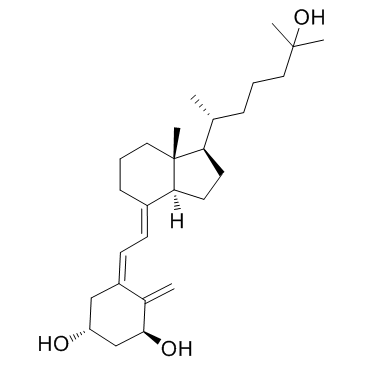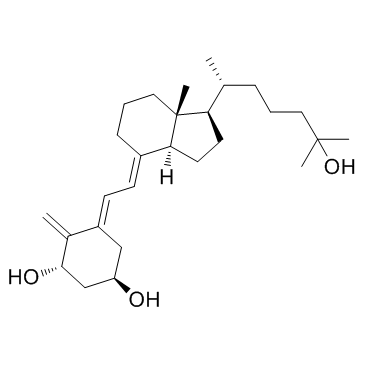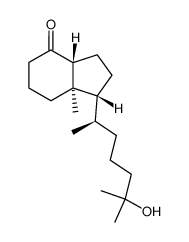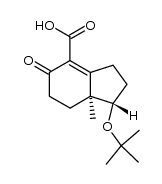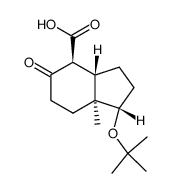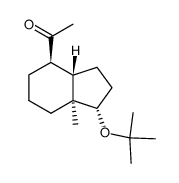32222-06-3
| Name | calcitriol |
|---|---|
| Synonyms |
(1R,3S,5Z)-5-[(2E)-2-[(1R,3aS,7aR)-1-[(2R)-6-hydroxy-6-methylheptan-2-yl]-7a-methyl-2,3,3a,5,6,7-hexahydro-1H-inden-4-ylidene]ethylidene]-4-methylidenecyclohexane-1,3-diol
MFCD00867079 1,3-Cyclohexanediol, 4-methylene-5-[2-[(1R,3aS,7aR)-octahydro-1-[(1R)-5-hydroxy-1,5-dimethylhexyl]-7a-methyl-4H-inden-4-ylidene]ethylidene]-, (1R,3S)- (1S,3R)-9,10-Secocholesta-5,7,10-triene-1,3,25-triol 1α,25-Dihydroxyvitamin D3 EINECS 250-963-8 |
| Description | Calcitriol is the most active metabolite of vitamin D and also a vitamin D receptor (VDR) agonist. |
|---|---|
| Related Catalog | |
| Target |
Human Endogenous Metabolite |
| In Vitro | Calcitriol exerts antiproliferative effects on cervical cancer cells in vitro. Cells decrease by 12.8% when treated with 100 nM Calcitriol for 6 days, compare with control. Inhibition of cell proliferation becomes more pronounced with the increase in Calcitriol concentration. The decrease is 26.1% and 31.6% for 200 and 500 nM Calcitriol, respectively. Treatment with Calcitriol for 72 h induces an evident accumulation of cells in the G1 phase, with approximately 66.18% in 200 nM and 78.10% in 500 nM, compare with the control (24.36%). Calcitriol treatment significantly decreases HCCR-1 protein expression compare with the control in a time- and dose-dependent manner[1]. Calcitriol significantly increases ERα mRNA in a dose dependent manner with an EC50 of 9.8×10-9 M[2]. |
| In Vivo | Chronic treatment with Calcitriol (150 ng/kg per day for 4.5 months) improves the relaxations (pD2: 6.30±0.09, Emax: 68.6±3.9% in Calcitriol-treated OVX, n=8). Renal blood flow in OVX rats is reduced in both kidneys, and the flow is restored by Calcitriol treatment. The increased expression of COX-2 and Thromboxane-prostanoid (TP) receptor in OVX rat renal arteries is reduced by chronic calcitriol administration[3]. High- and low-dose Calcitriol treatment significantly decreases the systolic blood pressure (SBP) in the fructose-fed rats by 14±4 and 9±4 mmHg, respectively, at Day 56. High-dose Calcitriol treatment (20 ng/kg per day) significantly increases serum ionized calcium level (1.44±0.05 mmol/L) compare with the other groups[4]. |
| Cell Assay | HeLa S3 cells are plated at a density of 1,000 cells/well in 96-well plates of Dulbecco’s modified Eagle’s medium (DMEM) with 10% fetal bovine serum (FBS), treated with 1% ethanol (control) or various concentrations of Calcitriol (100, 200, and 500 nM) for 72 h. A Cell Counting Kit8 (CCK-8) is used to determine cell proliferation. At 24, 48, 72, 96, 120, and 144 h after culturing with 200 nM Calcitriol, cells are harvested for analysis. Three independent experiments are performed in quadruplicate[1]. |
| Animal Admin | Adult female Sprague-Dawley rats weighing 200 to 220g are used in this study. Rats are housed in a temperature-controlled room (~23°C) with a 12-h light/dark cycle. The animals have free access to a standard diet and water. Ovariectomy (OVX) is performed on rats. At 6 months after the surgical procedure, the OVX rats are randomly assigned to either treatment with vehicle dimethyl sulfoxide (OVX+vehicle) or Calcitriol (150 ng/kg daily, OVX+calcitriol). Calcitriol treatment is given by oral gavage and lasted or 4.5 months. Blood pressure and serum Calcitriol level are measured[3]. |
| References |
| Density | 1.1±0.1 g/cm3 |
|---|---|
| Boiling Point | 565.0±50.0 °C at 760 mmHg |
| Melting Point | 119-1210C |
| Molecular Formula | C27H44O3 |
| Molecular Weight | 416.637 |
| Flash Point | 238.4±24.7 °C |
| Exact Mass | 416.329041 |
| PSA | 60.69000 |
| LogP | 6.12 |
| Vapour Pressure | 0.0±3.5 mmHg at 25°C |
| Index of Refraction | 1.547 |
| Stability | Air and Light Sensitive |
CHEMICAL IDENTIFICATION
HEALTH HAZARD DATAACUTE TOXICITY DATA
MUTATION DATA
|
| Symbol |



GHS02, GHS06, GHS08 |
|---|---|
| Signal Word | Danger |
| Hazard Statements | H225-H301 + H311 + H331-H370 |
| Precautionary Statements | P210-P280-P302 + P352 + P312-P304 + P340 + P312-P370 + P378-P403 + P235 |
| Personal Protective Equipment | Eyeshields;Faceshields;full-face particle respirator type N100 (US);Gloves;respirator cartridge type N100 (US);type P1 (EN143) respirator filter;type P3 (EN 143) respirator cartridges |
| Hazard Codes | T+:Verytoxic; |
| Risk Phrases | R26/27/28;R63 |
| Safety Phrases | S36/37/39-S45 |
| RIDADR | UN 2811 6.1/PG 1 |
| WGK Germany | 3 |
| RTECS | FZ4645000 |
| Packaging Group | I |
| Hazard Class | 6.1(a) |
| HS Code | 2942000000 |
| Precursor 6 | |
|---|---|
| DownStream 1 | |
| HS Code | 2942000000 |
|---|


